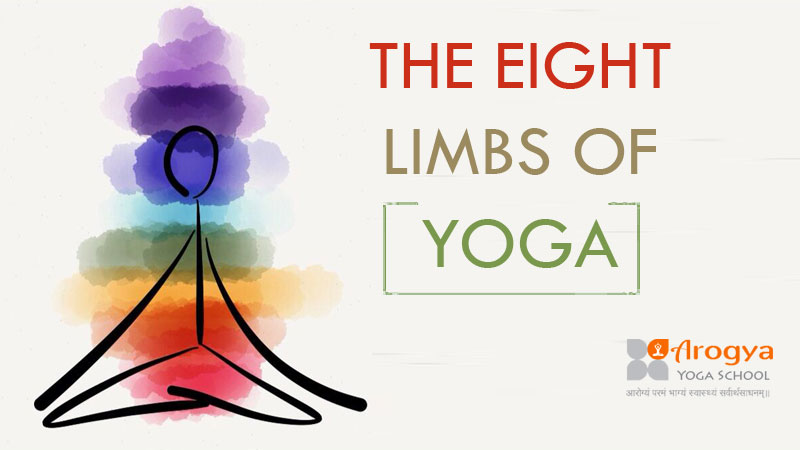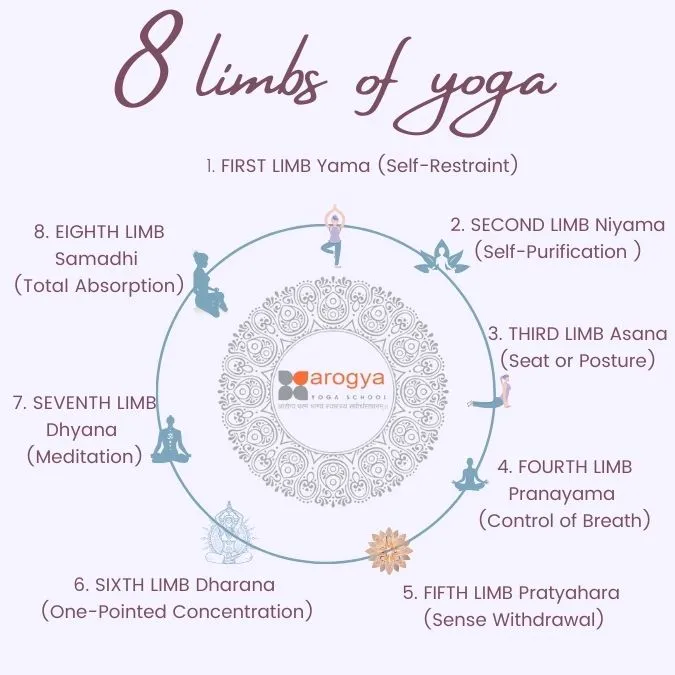
8 limbs of yoga
People know the Yoga Sutras as the eight limbs of yoga (Ashtanga). They are the first complete and written yoga system. Patanjali developed this framework around 400 CE, and it significantly shapes much of the contemporary yoga practice.
While the original sutras primarily emphasized mindfulness, modern Western yoga appears to concentrate more on physical aspects. It seems that, over time, the practice of yoga movements has become somewhat detached from its foundational philosophies.
To connect mindfulness in yoga with its movements, I suggest exploring The eight Limbs of Yoga. Allow yourself ample time to thoroughly comprehend it. Reflect on how much you can incorporate into your practice and everyday life.
This is a helpful summary of The eight Limbs of Yoga. This will introduce you to the main ideas of the philosophy. Understanding yoga’s philosophy and history can improve your practice. It can also help you find mindfulness and self-realization.
The eight members of Yoga of Patanjali help create a strong foundation for your journey. However, you must choose to confront your problems at their source. Reading and intellectualizing is not enough.
To enjoy all the benefits of yoga, use the eight principles in every part of your life. You need to fully embrace and dedicate yourself to this world and its people with the teachings outlined below.
The initial two limbs, Yama and Niyama, lay the groundwork. Here, we cultivate awareness and understanding.Yama and Niyama lay the foundation for everything to eat. A serious student should be aware of each member, each of these members need constant reflection. By committing to your study and practice, your depth of understanding for each member will deepen over time.

Modern yoga practitioners want quick results. Some jump right into yoga poses. Others only focus on meditation. They often forget about their physical health.
I would highly recommend starting with the first two limbs of Pantanjali. You will achieve the deepest and most satisfying practice if you practice the first two limbs at a high level. If you do not practice the first two limbs well, you will perform the other limbs less effectively. FIRST LIMB Yama (Self-Containment)
8 limbs of yoga
- FIRST LIMB Yama (Self-Restraint)
- SECOND LIMB Niyama (Self-Purification by Self-Restraint and Discipline)
- THIRD LIMB Asana (Seat or Posture)
- FOURTH LIMB Pranayama (Control of Breath)
- FIFTH LIMB Pratyahara (Sense Withdrawal)
- SIXTH LIMB Dharana (One-Pointed Concentration)
- SEVENTH LIMB Dhyana (Meditation)
- EIGHTH LIMB Samadhi (Total Absorption)
1- FIRST LIMB Yama (Self-Restraint)
The initial aspect of yoga, known as Yama, encompasses moral guidelines and self-discipline, shaping our interactions with others. It serves as the cornerstone of spiritual practice outlined in Patanjali’s Eight Limbs of Yoga from the Yoga Sutras.
The Five Yamas include:
– Ahimsa (Non-violence): Emphasizing kindness and compassion while steering clear of harm in our thoughts, words, and actions.
– Satya (Truthfulness): Upholding honesty in our speech and actions, always mindful of the principle of non-harm.
– Asteya (Non-stealing): Refraining from taking anything that is not willingly offered, including time and energy.
– Brahmacharya (Moderation): Exercising self-restraint, especially concerning desires, to foster balance and inner strength.
– Aparigraha (Non-possessiveness): Releasing greed and detachment from material possessions and outcomes.
By mastering Yama, individuals can cultivate inner peace and foster harmonious relationships, thus establishing a strong foundation for spiritual development.
2- Second Limb: Niyama (Self-Cleansing Through Self-Control and Discipline)
Niyama represents the second aspect of Patanjali’s Eight Limbs of Yoga, emphasizing personal discipline and internal development. Yama emphasizes ethical conduct towards others, while Niyama centers on self-discipline and spiritual cleansing.
The Five Niyamas:
1. Shaucha (Purity) – Maintaining cleanliness in body, mind, and environment. This encompasses physical hygiene, nutritious eating habits, and clarity of thought.
2. Santosha (Contentment) – Embracing life as it unfolds, fostering gratitude, and achieving tranquility in the current moment.
3. Tapas (Self-Discipline) – Cultivating inner resilience and resolve through regular practice, even in the face of obstacles.
4. Svadhyaya (Self-Study) – This involves reading sacred texts and reflecting on oneself. It helps you understand your true self and spiritual path.
5. Ishvarapranidhana (Surrender to the Divine) – Letting go of the ego and trusting a higher power. Embrace life with faith and devotion.
3- Third Limb : Asana (Seat, Posture or Position)
Asana refers to the physical yoga postures. Modern yoga practitioners associate asanas with flexibility and strength. But their true purpose is to prepare your body and mind for mediation.
Asana Meaning and Purpose:
- The term “seat” originally meant a comfortable and stable posture for meditation.
- Patanjali describes asana in his Yoga Sutras (2.46) as “Sthira Sukham Asanam.” This means that a pose must be stable (sthira), and comfortable (sukham).
- Asanas can help you to purify your body and improve physical fitness. They also develop mental focus.
4- Fourth Limb: Pranayama (Control of Breath)
Pranayama focuses on breathing control and regulates the flow of the life force energy within the body. A bridge connects the (asanas) with the (meditation) elements of yoga.
Pranayama – Meaning (breathing exercises)
- The word “Pranayama” comes from two Sanskrit words:
- Prana – Life force energy, vital breath.
- Ayama Control, expansion or regulation.
- “Regulation or expansion of life force by breath control” is what Pranayama refers to.
Benefits and Purpose of Pranayama :
- Increases Vital Energy– Improves overall vitality by increasing oxygen intake.
- Calms Mind– Helps to reduce anxiety, stress and mental restlessness.
- Prepares you for meditation – Deepens your focus and awareness leading to inner stillness.
- Regulates Nervous System – Promotes emotional stability by regulating the nervous system.
- Cleanses Body– Removes toxins, and purifies energy channels ( Nadis).
5- Fifth Limb: Pratyahara (Sense Withdrawal)
Pratyahara focuses on withdrawing senses from distractions to bring awareness inward. This is the link between the outer (physical and mental) and the inner (mental) aspects. It prepares the mind for meditation and deeper concentration.
Meaning and Pratyahara in
- “Prati” means “against”, “withdraw” or “reject”.
- “Ahara” means “food or input.”
- Pratyahara is “withdrawal of sensory distractions”.
Benefits and Purpose of Pratyahara:
- Detachment From Distractions– Helps to control the senses rather than being controlled by them.
- Calm Mind– Prepares your mind for meditation ( Dhyana) and deep concentration ( Dharana).
- Freedom From External Influences Reduces emotional responses to sensory experiences.
- Inner awareness – Strengthens self discipline and enhances spiritual development.
Pratyahara –
- Mindful awareness– Observing emotions and thoughts without reacting.
- Closing The Senses– Practice meditation with closed eyelids, in silence or with minimal outside stimulation.
- Breath awareness – Focusing on your breath to remove yourself from the world.
- Yogic Sleep (Yogic Nidra) A guided relaxation technique which induces deep inner focus.
Pratyahara, or the practice of deep concentration, leads to a state of inner peace and higher levels in meditation.
6- Sixth Limb: Dharana (One-Pointed Concentration)
Dharana focuses on mental focus and concentration. The practice is to focus the mind on one object, thought or awareness in preparation for deep meditation.
Meaning of Dharana in
- “Dha”, is “to hold or to support.”
- “Rana”, means to “focus or concentrate.”
- Dharana is “holding your mind steady on one object.”
Benefits and Purpose of Dharana
- Improves Focus– Teaches the mind to stay steady and unaffected.
- Prepares Meditation– – Lays the foundations for Dhyana(meditation), and Samadhi.
- Calms Mind Reduces mental restlessness.
- Enhances Self-Awareness– Aids in deeper exploration of self and inner growth.
Practice Dharana:
- Trataka (Gazing Mediation)– Fixing your gaze on a flame of a candle or a single object.
- Mantra Repeat– Mentally repeating an occult sound or phrase.
- Breath awareness – Focusing on the natural breathing rhythm.
- Visual Mediation– Focusing on an inner image such as a symbol or deity.
- Chakra meditation – Focusing on the energy centers of the body.
Dharana, the gateway into deep meditation leads the practitioner to Dhyana(meditative absorption), and eventually Samadhi.
7- Seventh Limb: Dhyana (Meditation)
Dhyana refers to Meditation, which is a continuous and effortless flow of attention toward a particular object or thought. The deepening of Dharana is when the mind becomes fully absorbed.
Meaning and definition of Dhyana
- The word “Dhi”, is a synonym for “mind” and “contemplation.”
- “Yana”, is “movement or flow”.
- Dhyana is “the uninterrupted stream of awareness towards one focal point (point of focus).
Benefits and Purpose of Dhyana
- Brings inner peace – Enhances mental clarity, emotional stability.
- Increases Spiritual Awareness– Leds to self-realization, and a deeper connection to the inner self.
- Calms Nervous System and Promotes Relaxation– Reduces stress and anxiety.
- Improves mindfulness– Enhances focus, presence and overall well-being.
Practicing Dhyana:
- Silent meditation Sitting still, focusing attention on the breath or inner awareness.
- Mantra Mediation – Repeating sacred sounds, e.g. Om and Sohum.
- Guided Mediation– Follow a teacher’s voice or visualisation.
- Loving Kindness Meditation– Cultivating compassion towards oneself and others.
- Chakra Mediation – Meditation on the energy centers in the body.
Dhyana is the core of Yoga practice. It leads to the final stage called Samadhi.
8- Eighth Limb: Samadhi (Total Absorption)
Samadhi represents the highest and final limb of Patanjali’s Eight Limbs of Yoga. A state of spiritual enlightenment and union with God exists. This is the culmination ( Dhyana ) of deep meditation where the practitioner transcends their ego to merge with pure consciousness.
Samadhi – Meaning in
- “Sama”, is “equal”, “balanced” or “balanced”.
- The term “Dhi” is “intellect”, “awareness” or “intelligence”.
- Samadhi is “a complete state of stillness and union with your higher self.”
Samadhi Stages:
- Savikalpa Samadhi– Although the mind is active, there is a deep focus on a thought or object.
- Nirvikalpa Samadhi– The mind is completely quiet, without thoughts or duality.
- Kaivalya The ultimate state of Self-Realization, beyond Time and Space.
The Purpose of Samadhi and its Benefits:
- The Ultimate Experience of Bliss– A state beyond all worldly suffering.
- Freedom From the Ego– The illusion separateness is gone.
- Awakening to Spirituality– A profound realization of interconnectedness.
- Inner Peace Complete– A mind that is free of distractions, fears, and desires.
The Path to Samadhi :
- Regular meditation (Dhyana) – Deep, uninterrupted practice.
- Surrendering Ego– Letting Go of Personal Identity and Attachment.
- Living The Yamas & Niyamas – Ethical and Self-Disciplinary Practices.
- Detachment From Desires– Practice non-attachment towards outcomes.
Samadhi, or union with the true self is the ultimate goal for yoga.




